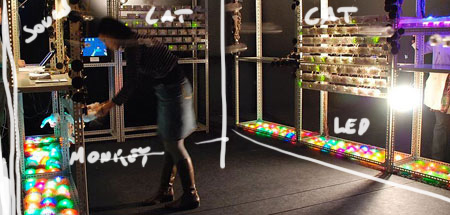
The Reconfigurable House is an environment constructed from thousands of low tech components that can be "rewired" by visitors. The project is a critique of ubiquitous computing "smart homes", which are based on the idea that technology should be invisible to prevent DIY...
In contrast to such homes, which are not able to adapt structurally over time, the many sensors and actuators of Reconfigurable House can be reconnected endlessly as people change their minds so that the House can take on completely new behaviours.
Some people may walk into the House and find that things are too noisy, too reactive, or maybe not reactive enough. Perhaps some people may prefer sound outputs, others may prefer lights. Still others may prefer the delicate feeling of mist. Each visitor will be able to use a simple interface to configure the reactions and interactions of the house in a completely different way. The "hardware" stays the same, but visitors completely transform the "software"! In this openness, the Reconfigurable House also demonstrates authentic interaction: where the system not only reacts to visitors, but, at a higher level, also changes the way that its reaction is computed...
The house consists of walls and devices that respond to sound, light, touch, footsteps, phone calls, mp3 players and even distant remotely connected spaces. Through elements like the Cat Brick Wall, Mist Laser garden, Monkey Corridor and Radio Penguin Ceiling, constructed from hacked low tech toys and gadgets, the house can be inexpensively recreated by even those who are not experts in electronics. This means that not only is the software of the House open, but the hardware is too.

